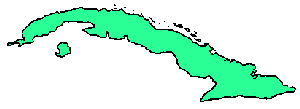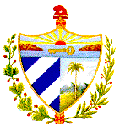A Synposis of the Cuban Background Through Selected Significant Illustrations
![]()
INTRODUCTION
 DISCOVERY - 15th Century
DISCOVERY - 15th CenturyLand of Grace
"The many different types of palm trees, the tallest and most beautiful I have ever seen, and innumerable big and green trees; the birds with rich plumage and the green fields, make this country, my dear Lords, of such an incomparable beauty that it surpasses all others in grace and charm and is comparable to day to night splendor. I have become so stunned at seeing such beauty that my words are inadequate."
Christopher Columbus To King Fernando and Queen Isabel of Spain, 1492
"Spain...concentrated all its energies and capabilities in the hand of the king."
 "The main characteristic of the Spanish empire (was) its
centralization. Unlike in North America, the Spanish Crown was the
decisive factor in the colonization (of Cuba) as well as in the government
and organization of cities. During the first 100 years of Spanish
rule (in Cuba) each ship brought new decrees and laws from the
Governing Body in Seville (Spain) or from the West Indies Council
(in Spain). In 1635 there were more than 400,000 decrees, 2500 per
year, since Columbus discovered America.
"The main characteristic of the Spanish empire (was) its
centralization. Unlike in North America, the Spanish Crown was the
decisive factor in the colonization (of Cuba) as well as in the government
and organization of cities. During the first 100 years of Spanish
rule (in Cuba) each ship brought new decrees and laws from the
Governing Body in Seville (Spain) or from the West Indies Council
(in Spain). In 1635 there were more than 400,000 decrees, 2500 per
year, since Columbus discovered America.... Except for the highest officials, most government officials were paid poorly, thus, corruption was common."
Hugh Thomas CUBA - The Fight For Freedom 1762-1909 pp. 70-71
La mano del mendigo
"The Cuban War of Independence, which began on February 24, 1895, was a vicious and brutal conflict.... ...raw rebels faced numerically superior and well trained (Spanish) regulars. The population of Cuba at that time was 1,500,000, and Spain sent more than 200,000 soldiers to subdue the country."
"Build up the souls and set them on fire. And make the truth shine
like lightning, and let free and honest men follow it."
"Con Todos y Para Bien de Todos" by Jose Marti, Cuban Apostle for
the Cuban War of Independence from Spain 1853-1895
Source: MARTI by Antonio Espina

YEARS OF INDEPENDENCE - 1901-1959
"by the 1950s...Cuba had attained the highest standard of living of any semi-tropical or tropical country in the world, except possibly for Venezuela. According to a U.S. Department of Commerce report, Cuban national income in 1956 had reached levels which gave the Cuban people 'one of the highest standards of living in Latin America.' (US Department of Commerce, Investment in Cuba, Washington, DC:Government Printing Office 1956 p.184)"
Dagger in the Heart by Mario Lazo p. 96.

MUSIC
During its years of independence, Cuba produced five ballroom
dances which became popular worldwide. The fact that they became
popular worldwide proves that they were outstanding. They were all
very original and happy music. This music was just delightful. It is evidence of a capable,
prosperous and happy people. The dances are the Habanera, the Mambo, the
Rhumba, the Conga and the Cha-Cha.
By Lillian Martinez
Cuban MIDI Music
Use Back button to get back.
CHURCH
The (Spanish Catholic) Church had many of the weaknesses of the
political parties and suffered because it had not contributed at
all in the fight against Spain.... During the beginning of the
(Cuban) Republic, clergymen continued to be Spaniards. During
Menocal's government (in Cuba) almost two thirds of clergymen in
Cuba were foreigners, mostly Spaniards....
Hugh Thomas CUBA - The Fight for Freedom 1909-1958, p. 891.
THE MILITARY
The Cuban military was undermined because presidents granted promotions with easy requirements. Poor governments kept the military happy by granting concessions. Dictator Batista's military was so undermined that it was incapable of fighting.
Source: La Gran Mentira by Ricardo Adam Y Silva
SPANISH POLITICAL LEGACY
In general...frauds originated in the Spanish customs, since the
public officials and judges were poorly paid, or had to pay so much
for their appointments, that corruption was the only effective
method of remuneration.
...Pardons could be bought.
Hugh Thomas CUBA...1909-1958, p. 961
To commit fraud did not carry a social stigma.
IBID. p. 963
(Dictator Batista) suspended the old Congress...
IBID. p. 1025

El Profeta habla de los cubanos
RURAL FOLKLORE
The Guajiro - The guajiro is the Cuban farmer. The guajiro is a pictouresque fellow because of his appearance and manners. He usually wears a palm tree straw hat, tanned ox leather shoes, and a machete large knife on his belt. He likes cock fights, decimas songs (ten syllable verses with guitar accompaniment), coffee and tobacco. He is shy and humble, almost always very poor, and generally is courteous and generous.
Un Catauro de Folklore Cubano
by Antonio Carbajo, p.12
English Translation of CUBA by Lillian Martinez
Photo: Cubans fleeing Castro's dictatorship
WEBMASTER'S STATEMENT:
Lillian Martinez
Cuba or the Pursuit of Freedom
XLData Net
Copyright © 1997, XLData Net.
by Hugh Thomas
by Ortega Y GassetCuba Links
Lillian Martinez, Webmaster
USA
512.246.2597
Email to Webmaster
Created: 9/4/1997
Revised: May 2010